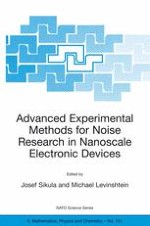2004 | OriginalPaper | Chapter
Measurement and Analysis Methods for Random Telegraph Signals
Author : Z. Çelik-Butler
Published in: Advanced Experimental Methods For Noise Research in Nanoscale Electronic Devices
Publisher: Springer Netherlands
Included in: Professional Book Archive
Activate our intelligent search to find suitable subject content or patents.
Select sections of text to find matching patents with Artificial Intelligence. powered by
Select sections of text to find additional relevant content using AI-assisted search. powered by
Large-area device noise models are based on ensemble averaging techniques. Typically, the physical mechanisms leading to fluctuations of microscopic entities, such as charge carrier number or mobility can be modeled by connecting these fluctuations to noise in a measurable device parameter, such as voltage or current. In the process, ensemble averaging of independent (or some times dependent) fluctuators is done to obtain an “average” power spectral density function that agrees with the experimentally measured one. This procedure breaks down in small area devices where the observed noise is basically a single electron phenomenon. Small devices can be manufactured with a single defect which in time domain show only two level switching signals known as burst noise and/or Random Telegraph Signal (RTS) noise. The RTS noise in sub-micron MOSFETs usually dominates over all the other noise sources and becomes a major noise generator for low frequency region of spectrum. With usual oxide and interface trap densities in the order of 1010 eV cm-2, active traps being located only within a few k B T around the Fermi level, a sub-micron MOSFET of 1.0*0.15 μm dimensions will have only 78% chance of having an active electron trapping site. Therefore, it will be a hit or miss situation to observe RTS in the signal. It is essential to be able to perform accurate measurements of RTS both in time and frequency domains, not only to be able to understand, analyze and model the noise in these advanced devices, but also to use RTS measurements as a characterization tool for the interface and bulk traps responsible for these RTS events.
